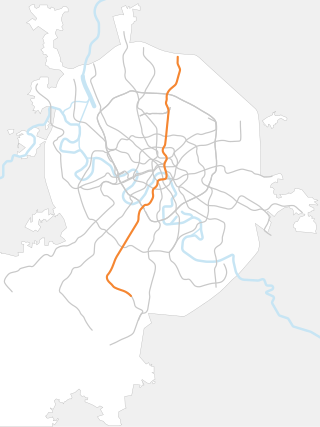
The Kaluzhsko-Rizhskaya line is a line of the Moscow Metro, that originally existed as two separate radial lines, Rizhskaya and Kaluzhskaya opened in 1958 and 1962, respectively. Only in 1971 were they united into a single line as the central section connecting the stations Oktyabrskaya to Prospekt Mira was completed. It was also the first line in Moscow to have a cross-platform transfer. The Rizhsky radius is roughly aligned with a northern avenue Prospekt Mira, while the Kaluzhskiy radius generally follows a southwestern street Profsoyuznaya Ulitsa. Presently, the Kaluzhsko-Rizhskaya line is the third busiest in the system with a passenger traffic rate of 1.015 million per day. It has a bi-directional length of 37.8 kilometres (23.5 mi), and a travel time of 56 minutes, typically it is coloured orange on Metro maps and numbered 6.

Rizhskaya is a Moscow Metro station in the Meshchansky District, North-Eastern Administrative Okrug, Moscow. It is on the Kaluzhsko-Rizhskaya Line, between Prospekt Mira and Alekseyevskaya stations. It is named after the nearby Rizhsky railway station and was designed by Latvian architects Artūrs Reinfelds and Vaidelotis Apsītis.
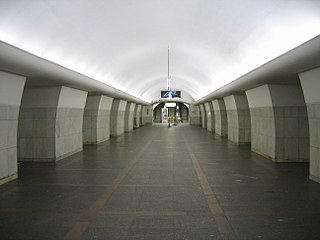
Oktyabrskaya is a Moscow Metro station in the Yakimanka District, Central Administrative Okrug, Moscow. It is on the Kaluzhsko–Rizhskaya line, between Shabolovskaya and Tretyakovskaya stations. Oktyabrskaya opened on 13 October 1962 and was originally the northern terminus of the Kaluzhskaya line before the latter extended northwards in 1970.
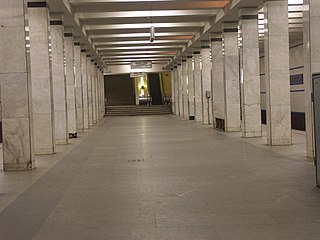
Akademicheskaya is a station on the Moscow Metro's Kaluzhsko-Rizhskaya Line. It is named for the several Akademichesky Proyezd streets formerly located nearby, which were themselves named after the Russian Academy of Sciences but have all been renamed since. Akademicheskaya opened on October 13, 1962, and was designed by Yuliya Kolesnikova, Petukhova, and Fokina. Built to the relatively new pillar-trispan design, which became prevalent in the 1960s due to its low construction costs. The station has white marble pillars accented with a stripe of black marble near the top. The walls, originally faced with white tile with four horizontal blue stripes, were re-covered in 2003 with similarly coloured aluminium planes for a cleaner, more modern look.
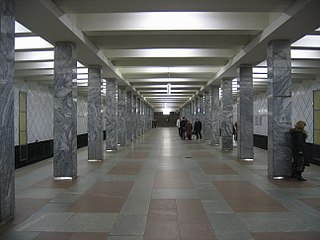
Profsoyuznaya is a station on the Kaluzhsko-Rizhskaya Line of the Moscow Metro. Opened in 1962.

Novye Cheryomushki is a train station on the Kaluzhsko-Rizhskaya Line of the Moscow Metro. It was opened as the final segment of the Kaluzhskiy radius on 13 October 1962, and served as a terminus for two years.

Kaluzhskaya is a station on the Kaluzhsko-Rizhskaya Line of the Moscow Metro. It is named after the Russian town of Kaluga. Kaluzhskaya opened on 12 August 1974, replacing a temporary station of the same name that had been operating since 1964. The new station was built to the column tri-span design with tapered octagonal columns in place of the usual square ones. Also the step of the columns was extended from 4 metres to 6.5, and the height of the ceiling raised. The columns are faced with pink Baikal marble, the walls are tiled with white ceramic and decorated with metallic artworks ; the floor is laid with grey granite. The architects of the station were N. Demchinskiy and Yuliya Kolesnikova.
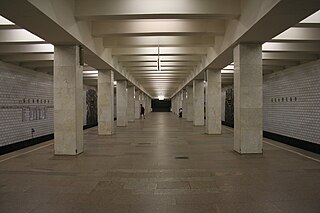
Belyayevo is a station on the Kaluzhsko-Rizhskaya Line of the Moscow Metro. It opened on 12 August 1974 as part of the southwest extension of the Kaluzhsky radius
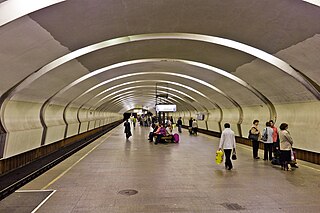
Konkovo is a station on the Kaluzhsko-Rizhskaya Line of the Moscow Metro.
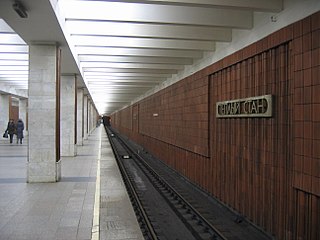
Tyoply Stan is a station near the southern end of the Moscow Metro's Kaluzhsko-Rizhskaya Line.

Yasenevo is a station on the Kaluzhsko-Rizhskaya Line of the Moscow Metro. It was designed by N. Shumakov, G. Mun, and N. Shurygina and opened on 17 January 1990. Yasenevo has round, greenish marble columns and walls faced with yellowish metallic tile and pink marble. The recessed oblong spaces between ceiling beams house chandeliers of a simple geometric design.
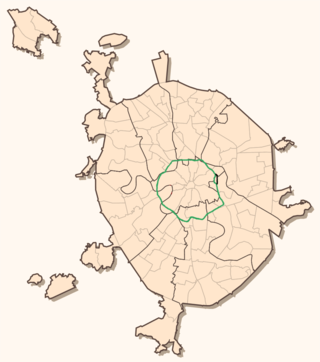
The Third Ring Road, or The Third Ring, is a beltway around central Moscow, Russia, located between the Garden Ring in the city centre and the Moscow Ring Road (MKAD).
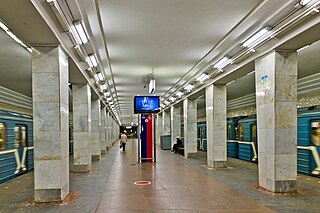
Leninsky Prospekt is a station on the Kaluzhsko-Rizhskaya Line of the Moscow Metro. It was built in 1962 to a variant of the standard column tri-span design, which included a more vaulted central span. The pillars are faced with white marble with a strip of gray at the base and the outer walls are tiled. The original metal light fixtures still run the length of each platform span were replaced in 2004 with more utilitarian fluorescent fixtures. The architects of the station are A. Strelkov, Nina Alexandrovna Aleshin, Yuriy Vdovin, V. Polikarpov and A. Marova.
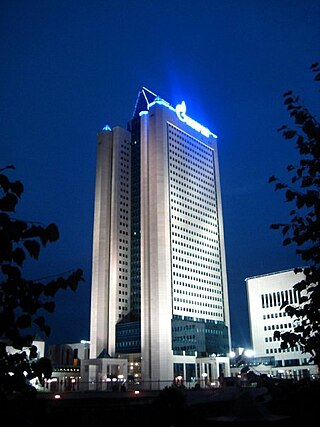
Cheryomushki District, formerly Brezhnevsky District, is a district of South-Western Administrative Okrug of the federal city of Moscow, Russia. Population: 102,619 (2010 Census); 89,264 (2002 Census).

Leninsky Avenue is a major avenue in Moscow, Russia, that runs in the south-western direction between Kaluzhskaya Square in the central part of the city through Gagarin Square to the Moscow Ring Road. It is a part of the M3 highway which continues from Moscow to Kaluga and Bryansk to the border with Ukraine, and used to provide connections with Kyiv and Odesa. It is also a part of the European route E101 connecting Moscow and Kyiv.
South-Western Administrative Okrug, or Yugo-Zapadny Administrative Okrug, is one of the twelve high-level territorial divisions of the federal city of Moscow, Russia. As of the 2010 Census, its population was 1,362,751, up from 1,179,211 recorded during the 2002 Census.

Konkovo District is an administrative district (raion) of South-Western Administrative Okrug, and one of the 125 raions of Moscow, Russia. The area of the district is 7.179 square kilometers (2.772 sq mi). Population: 97,847 .It is located in the south of the city, along the Kaluzhsko-Rizhskaya (orange) metro line.

Ploshchad Gagarina is a station on the Moscow Central Circle of the Moscow Metro. The station offers a free direct transfer to Leninsky Prospekt of the Kaluzhsko-Rizhskaya Line. Ploshchad Gagarina is the only underground station on the Moscow Central Circle line.

Nakhimovsky Prospekt is an avenue in Moscow, Russia, that runs from Kolomensky Proyezd in the east to Vavilova Street in the west. After that, it continues as Lomonosovsky Prospekt.

Nina Aleksandrovna Aleshina was a Russian architect and head of the design department Metrogiprotrans for the Moscow Metro for a decade. Nineteen stations of the subway system were projects she participated in or led. She was honored with many awards during her career, including the designation in 1985 of Honored Architect of the Russian Soviet Federative Socialist Republic




















